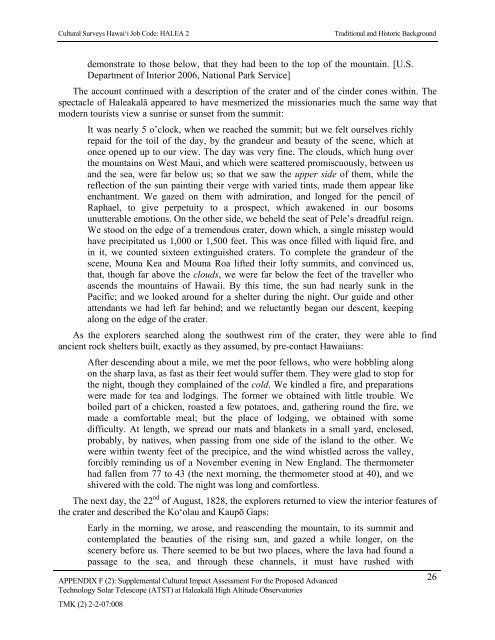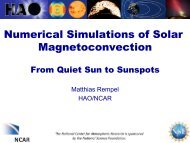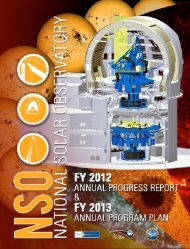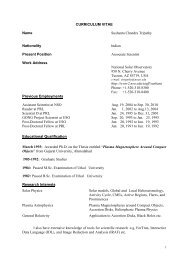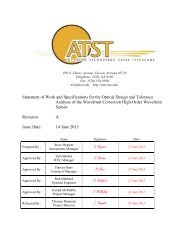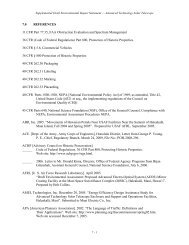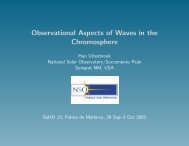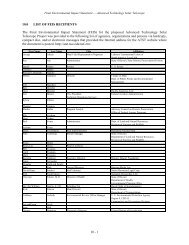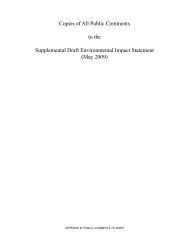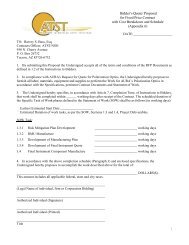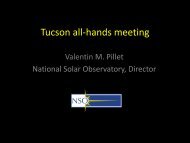F2 - ATST
F2 - ATST
F2 - ATST
Create successful ePaper yourself
Turn your PDF publications into a flip-book with our unique Google optimized e-Paper software.
Cultural Surveys Hawai‘i Job Code: HALEA 2Traditional and Historic Backgrounddemonstrate to those below, that they had been to the top of the mountain. [U.S.Department of Interior 2006, National Park Service]The account continued with a description of the crater and of the cinder cones within. Thespectacle of Haleakalā appeared to have mesmerized the missionaries much the same way thatmodern tourists view a sunrise or sunset from the summit:It was nearly 5 o’clock, when we reached the summit; but we felt ourselves richlyrepaid for the toil of the day, by the grandeur and beauty of the scene, which atonce opened up to our view. The day was very fine. The clouds, which hung overthe mountains on West Maui, and which were scattered promiscuously, between usand the sea, were far below us; so that we saw the upper side of them, while thereflection of the sun painting their verge with varied tints, made them appear likeenchantment. We gazed on them with admiration, and longed for the pencil ofRaphael, to give perpetuity to a prospect, which awakened in our bosomsunutterable emotions. On the other side, we beheld the seat of Pele’s dreadful reign.We stood on the edge of a tremendous crater, down which, a single misstep wouldhave precipitated us 1,000 or 1,500 feet. This was once filled with liquid fire, andin it, we counted sixteen extinguished craters. To complete the grandeur of thescene, Mouna Kea and Mouna Roa lifted their lofty summits, and convinced us,that, though far above the clouds, we were far below the feet of the traveller whoascends the mountains of Hawaii. By this time, the sun had nearly sunk in thePacific; and we looked around for a shelter during the night. Our guide and otherattendants we had left far behind; and we reluctantly began our descent, keepingalong on the edge of the crater.As the explorers searched along the southwest rim of the crater, they were able to findancient rock shelters built, exactly as they assumed, by pre-contact Hawaiians:After descending about a mile, we met the poor fellows, who were hobbling alongon the sharp lava, as fast as their feet would suffer them. They were glad to stop forthe night, though they complained of the cold. We kindled a fire, and preparationswere made for tea and lodgings. The former we obtained with little trouble. Weboiled part of a chicken, roasted a few potatoes, and, gathering round the fire, wemade a comfortable meal; but the place of lodging, we obtained with somedifficulty. At length, we spread our mats and blankets in a small yard, enclosed,probably, by natives, when passing from one side of the island to the other. Wewere within twenty feet of the precipice, and the wind whistled across the valley,forcibly reminding us of a November evening in New England. The thermometerhad fallen from 77 to 43 (the next morning, the thermometer stood at 40), and weshivered with the cold. The night was long and comfortless.The next day, the 22 nd of August, 1828, the explorers returned to view the interior features ofthe crater and described the Ko‘olau and Kaupō Gaps:Early in the morning, we arose, and reascending the mountain, to its summit andcontemplated the beauties of the rising sun, and gazed a while longer, on thescenery before us. There seemed to be but two places, where the lava had found apassage to the sea, and through these channels, it must have rushed withAPPENDIX F (2): Supplemental Cultural Impact Assessment For the Proposed Advanced 26Technology Solar Telescope (<strong>ATST</strong>) at Haleakalā High Altitude ObservatoriesTMK (2) 2-2-07:008


